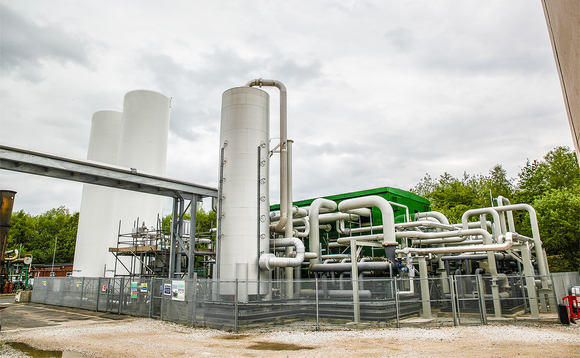
Market reforms needed to stimulate investment in projects capable of storing electricity for four hours or longer, according to Aurora Energy Research
Major investment is urgently needed to roll out up to 24GW of long-duration energy storage over the next 15 years to help smooth operation of the grid as it contends with a rapid influx of intermittent wind power capacity, Aurora Energy Research has warned.
The energy consultancy stressed that Britain's electricity system had the potential to be clean, affordable and reliable in keeping the lights on, in line with the government's goal for a net zero power grid dominated by renewables technologies by 2035.
But it warned major investment was urgently needed to build up energy security as the transition takes hold, and that while flexibility technologies and lithium-ion battery storage would play their part, systems that can store electricity for longer periods would also be critical for net zero.
In research published last week, it estimated up to 24GW of so-called long duration energy storage capacity - generally defined as any technology capable of storing power for longer than four hours, which is the typical length of storage offered by lithium-ion battery facilities - would need to be scaled within the next 15 years in order to support Britain's increasingly decarbonised grid.
By introducing long duration energy storage (LDES) capacity in large quantities by 2035, it could help reduce the UK's carbon emissions by 10 million tonnes per year, while also reducing the costs of running the grid by £1.13bn, amounting to a £26 cut in the annual average energy bill, it estimated.
Long duration energy storage technologies including pumped hydro, liquid air energy storage (LAES), flow batteries, and compressed air energy storage (CAES) are all capable of providing well over four hours of electricity of storage, potentially as long as days, weeks or even months.
But present LDES capacity stands at a fraction of what is required to deliver a decarbonised grid, and without an eight-fold scale-up over the next decade and beyond the UK's target for a net zero grid by 2035 is "unachievable", according to Aurora Energy Research.
Felix Chow-Kambitsch, head of commissioned projects for Western Europe at Aurora Energy Research, said accelerated deployment of wind and solar power over the next 15 years would mean a "large requirement" for long duration electricity storage to balance the grid.
"LDES provides a valuable contribution to system security and operability in a high renewables energy system," he said. "In addition to providing low carbon firm capacity, LDES technologies also provide a wide range of balancing and ancillary services to help manage the electricity network."
However, the research warns that urgently needed investment in LDES technologies still faces numerous hurdles in the UK due to high upfront costs, long lead times, a lack of revenue certainty and a lack of market support signals.
It therefore recommends policy support and market reforms to provide revenue certainty and address the missing markets for LDES in order to recognise the full value of such technologies for the UK grid and help enable a rapid scale up in capacity.
In addition to such direct support such as establishing an adapted ‘cap and floor' mechanism model to provide guaranteed revenue for LDES technologies, reforms to the government's capacity market auctions to take account of carbon intensity could also help stimulate the market, it suggests.
The research, which has been backed by a host of energy firms including Drax, SSE, Engie, Highview Power and the Intelligent Land Investments Group, comes as the sector awaits the outcome of the UK government's call for evidence on LDES.
Mark Wilson, CEO of clean energy developer ILI Group, said market reforms would unlock the investment case for a raft of LDES projects across the UK.
"Long-duration energy storage, storage over four hours in particular, is crucial to the UK's net zero ambitions," he said. "Without energy projects in place the renewable generation capacity in the country will soon hit a 'Green Glass Ceiling' whereby adding more 'variable' renewable generation actually threatens grid stability and security of supply in our grid network."
It follows related news last week that Scottish Water has finished installing its first combined solar power and battery storage facility near its Perth waste water treatment works on the River Tay.
The £2m project is expected to provide around a quarter of the electricity needed to treat water that has been used by customers in the city, with 2,520 solar panels having been installed on land adjoining the treatment works, alongside four vanadium flow batteries manufactured by Invinity Energy Systems.
The flow batteries are capable of storing up to 0.8 megawatt hours (MWh) of power generated by the solar panels, and together the system boasts a combined output of over 1MW, allowing the solar energy to be used at any time of the day or night, the firm said.
Scottish Water said the new system would reduce the water treatment site's carbon footprint by around 160 tonnes of CO2 per year, the equivalent of offsetting 580,000 miles from the average passenger car, while also helping rapid electric vehicle charging points which have been installed at the site.
It estimates the solar and energy storage system will help reduce the energy costs of water treatment at the site by around 40 per cent.
"By harnessing this technology, we now have a much wider opportunity to install renewables schemes that were previously unviable due to grid constraints," explained Scottish Water Horizons' business development manager Donald MacBrayne. "It's a massive step forward for us and will form an integral part of how we cut our emissions in the coming years."